Class 10 Exam > Class 10 Notes > Physics for GCSE/IGCSE > Gravitational Effects on Orbits
Gravitational Effects on Orbits | Physics for GCSE/IGCSE - Class 10 PDF Download
| Table of contents |

|
| Gravitational Field Strength |

|
| Gravitational Attraction of the Sun |

|
| Sun's Gravitational Field & Distance |

|
| Comet Orbits and Energy Changes |

|
Gravitational Field Strength
- The impact of gravity on various planets influences an object's weight on that particular planet.
- Weight is described as the force exerted on an object due to gravitational pull.
Key Points
- Planets possess potent gravitational fields, leading them to attract nearby masses with a robust gravitational force.
- Due to weight considerations:
- Objects remain firmly grounded.
- Objects invariably descend towards the ground.
- Satellites are maintained in their orbits.
- Objects are attracted towards the center of the Earth due to its gravitational field strength
- Both the weight of any object and the value of the gravitational field strength differ between Earth's surface and other celestial bodies
- The greater the mass of a planet, the stronger its gravitational field strength, resulting in a larger attractive force towards its center
- Gravitational field strength (g) varies with distance from a planet; it is relatively consistent on a planet's surface but decreases with distance
- The value of g can vary significantly on different planets and moons
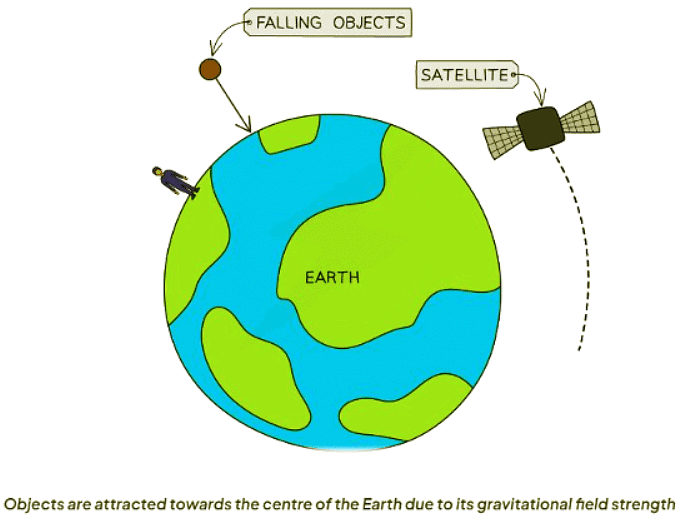
- Both the weight of any object and the value of the gravitational field strength (g) differ between Earth's surface and other celestial bodies
- The greater the mass of a planet, the stronger its gravitational field strength, resulting in a larger attractive force towards its center
- Gravitational field strength (g) varies with distance from a planet; it is relatively consistent on a planet's surface but decreases with distance
- The value of g can vary significantly on different planets and moons
Gravitational Field Strength
- The gravitational field strength of a planet increases with its mass, leading to a stronger attractive force towards its center.
- Gravity varies with distance from a planet, but remains relatively constant on the planet's surface. The field weakens as distance increases.
- On a planet's surface, gravitational field strength varies significantly. For instance:
- Earth has a gravitational field strength of about 10 N/kg.
- The Moon's surface has weaker gravity compared to Earth, making it easier to lift objects there.
- Gas giants like Jupiter and Saturn have stronger gravity than Earth, making it harder to lift objects on them.
- Concept of Gravitational Field Strength
- On the Moon, lifting a mass is easier compared to Earth due to lower gravitational field strength.
- Gas giants like Jupiter and Saturn have a higher gravitational field strength than Earth, making it harder to lift masses.
- Impact of Gravitational Field Strength on Weight
- On planets like Jupiter, an object's mass remains constant throughout space.
- However, due to increased gravitational field strength, weight on such planets is significantly higher, leading to challenges like being unable to stand fully erect.
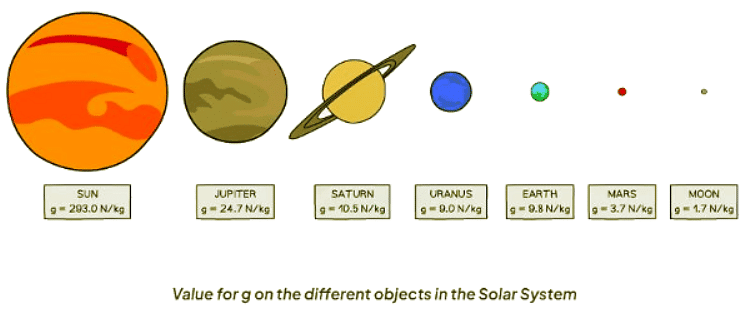
Value for g on the different objects in the Solar System:
- On planets like Jupiter, an object's mass remains constant while weight increases significantly, affecting activities like standing.
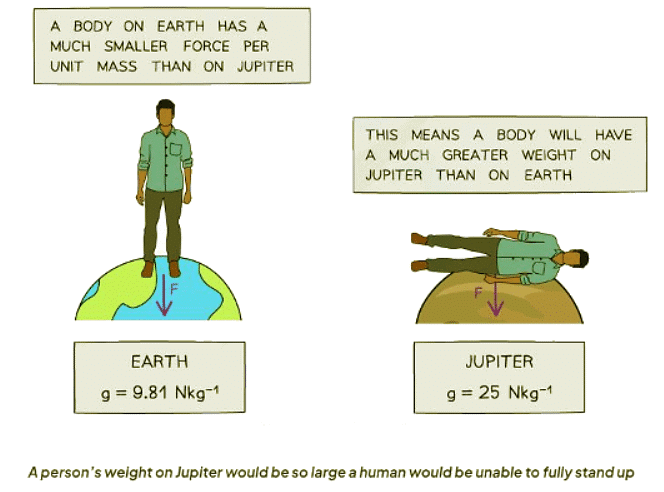
Gravitational Attraction of the Sun
- In our solar system, various objects orbit different types of planetary bodies.
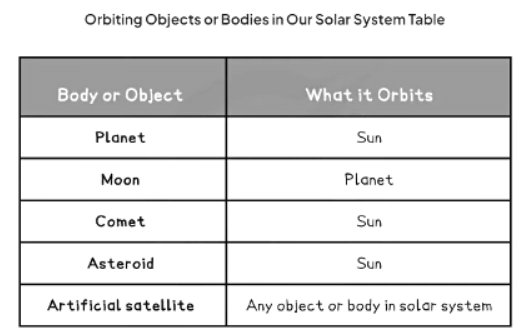
- When a smaller object orbits a larger one, like a planet orbiting the Sun, there exists a gravitational force pulling the smaller object towards the larger one.
- This gravitational attraction is what keeps objects like planets in orbit around massive bodies like the Sun.
- The force of gravity always acts inwards, towards the center of the larger body, ensuring the orbiting object remains in its path around the larger body.
Gravity and Orbits
- Gravity: Gravity provides the force that keeps a planet in orbit around the Sun.
- Gravitational Attraction: The gravitational force exerted by the larger body on the orbiting object is always attractive, acting towards the center of the larger body.
- Always Attractive: The gravitational force always acts towards the center of the larger body.
- Towards the Center: The force that keeps an object in orbit around the Sun is the gravitational attraction of the Sun, always directed from the orbiting object to the center of the Sun.
Effects of Gravity on Orbits
- Circular Path: Gravitational force causes objects to move and maintain a circular path.
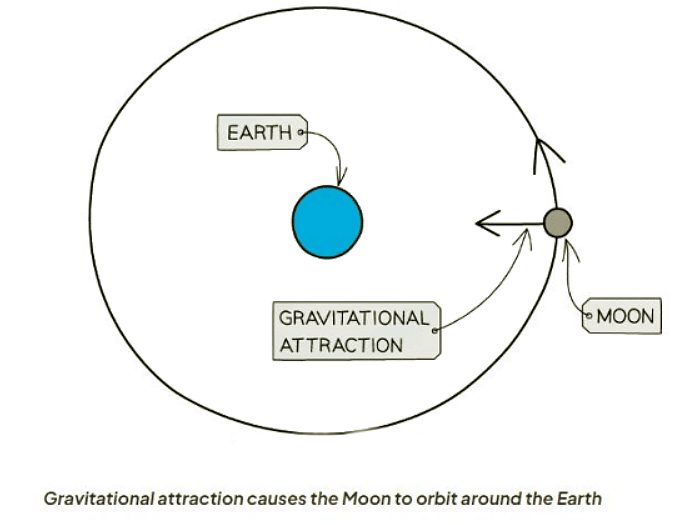
Sun's Gravitational Field & Distance
- When a planet moves farther from the Sun:
- The Sun's gravitational pull on the planet weakens.
- The planet's orbital speed decreases.
- For a planet to stay in a circular orbit:
- A centripetal force must act on it.
- This force, for planets circling the Sun, is gravity.
- The strength of the Sun's gravitational field influences the centripetal force on a planet:
- This influence diminishes as the planet moves farther from the Sun, resulting in a weaker centripetal force.
- The centripetal force is directly related to the orbital speed of the planet.
- Thus, planets at greater distances from the Sun have slower orbital speeds and longer orbital periods.
- Gravitational Force Strength:
- This force weakens as planets move farther from the Sun, resulting in a decrease in centripetal force.
- Orbital Speed and Distance:
- The centripetal force is directly related to the orbital speed, indicating that planets at greater distances from the Sun have slower speeds. Consequently, these planets have longer orbital durations.
- Impact of Distance on Planet Speed:
- Data comparing planets' orbital distances and speeds reveals significant variations. For instance, Neptune moves notably slower than Mercury.
- Clarification on Gravity Terminology:
- When discussing gravity, it's crucial to use precise terms like 'gravitational attraction,' 'strength of the Sun's gravitational field,' or 'force due to gravity.' Avoid vague expressions such as 'the Sun's gravity' or 'force from the Sun' to ensure accuracy.

- This relationship is evident when comparing a planet's orbital distance with its orbital speed. For example, Neptune's speed is significantly slower than that of Mercury.
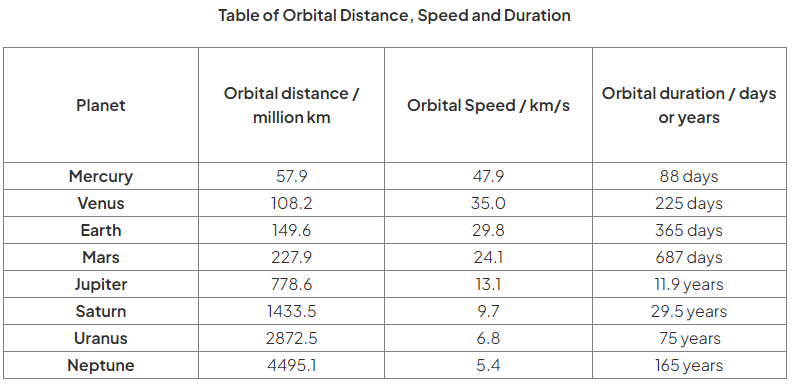
Question for Gravitational Effects on OrbitsTry yourself: What is the relationship between a planet's mass and its gravitational field strength?View Solution
Comet Orbits and Energy Changes
- When Comets Approach the Sun:
- Comets travel in highly elliptical orbits, speeding up as they approach the Sun.
- Changes in Orbit Radius and Speed:
- When a comet moves further away from the Sun:
- The radius of the orbit increases, resulting in a decrease in orbital speed due to a weaker gravitational pull from the Sun.
- When a comet approaches the Sun:
- The radius of the orbit decreases, leading to an increase in orbital speed due to the Sun's strong gravitational pull.
- When a comet moves further away from the Sun:
- Energy Conservation in Elliptical Orbits:
- Even though a comet's speed changes in an elliptical orbit, its energy remains conserved.
- Throughout the orbit, the comet experiences changes in gravitational potential energy and kinetic energy.
- As the comet approaches the Sun:
- It loses gravitational potential energy and gains kinetic energy, leading to an increase in speed causing a slingshot effect.
- The increased speed results in the comet being flung back out into space.
- As the comet moves away from the Sun:
- It gains gravitational potential energy and loses kinetic energy, causing it to slow down.
- Eventually, the comet falls back towards the Sun to form a stable orbit.

Conservation of Energy
- Throughout the orbit, the gravitational potential energy and kinetic energy of the comet change.
Comet Approaching the Sun
- As the comet moves closer to the Sun, it undergoes significant energy transformations:
- It loses gravitational potential energy and gains kinetic energy.
- This gain in kinetic energy causes the comet to accelerate, exhibiting a slingshot effect.
- Ultimately, the comet is propelled back into space after completing its orbit around the Sun.
Energy Transformations
- When the comet gains kinetic energy, it speeds up.
- The increase in speed results in a slingshot effect, leading to the comet being flung back into space.
Comet Moving Away from the Sun
- As the comet moves away from the Sun, a different set of energy changes occur:
- It gains gravitational potential energy while losing kinetic energy.
- This process causes the comet to decelerate and eventually fall back towards the Sun.
Orbital Stability
- Through these energy exchanges, a stable orbit is established.
The document Gravitational Effects on Orbits | Physics for GCSE/IGCSE - Class 10 is a part of the Class 10 Course Physics for GCSE/IGCSE.
All you need of Class 10 at this link: Class 10
|
126 videos|182 docs|35 tests
|
FAQs on Gravitational Effects on Orbits - Physics for GCSE/IGCSE - Class 10
| 1. How does the gravitational field strength vary with distance from the Sun? |  |
Ans. The gravitational field strength decreases as the distance from the Sun increases. This relationship follows the inverse square law, meaning that the strength of the gravitational field is inversely proportional to the square of the distance from the Sun.
| 2. How does the gravitational attraction of the Sun affect the motion of objects in the solar system? |  |
Ans. The gravitational attraction of the Sun is responsible for keeping objects in orbit around it. It provides the centripetal force required to maintain the circular or elliptical paths of planets, comets, and other celestial bodies in the solar system.
| 3. How do changes in energy affect the orbits of comets in the solar system? |  |
Ans. Changes in energy can alter the orbits of comets in the solar system. For example, if a comet gains energy, its orbit may become more elongated, leading to a more eccentric path. Conversely, if a comet loses energy, its orbit may become more circular.
| 4. What are the gravitational effects on the orbits of celestial bodies in the solar system? |  |
Ans. Gravitational effects can cause perturbations in the orbits of celestial bodies, leading to variations in their paths over time. These effects can result from interactions with other massive objects, such as planets, or from changes in the gravitational field strength of the central body, like the Sun.
| 5. How does the Sun's gravitational field influence the stability of orbits in the solar system? |  |
Ans. The Sun's gravitational field plays a crucial role in maintaining the stability of orbits in the solar system. Its gravitational pull keeps planets and other objects in their respective orbits, preventing them from drifting off into space or colliding with each other.
Related Searches



















